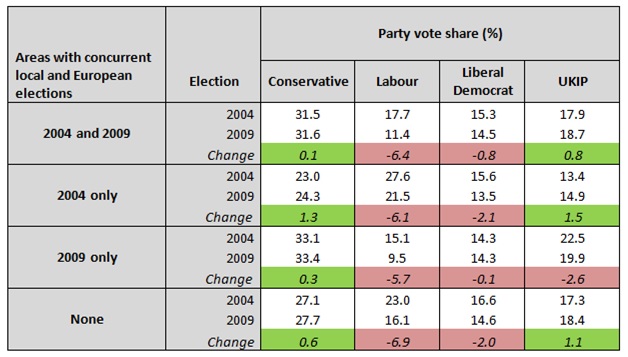Holding European Parliament elections concurrently with local elections increases turnout and benefits certain parties
The UK will hold hold elections for the European Parliament on 22 May, alongside the local government elections also taking place in many areas. Kevin Larkin has analysed the effect of holding these types of election on the same day, and finds that it leads to a small but significant increase in voter turnout. It may also hand an advantage to particular parties, with Labour most likely to benefit in May because of the pattern of local elections taking place.

Some strategies to boost European Parliament election turnout are less successful. Credit: Andy Mabbett (CC BY 2.0)
Low turnout has been a feature of direct elections to the European Parliament in Great Britain since they were introduced in 1979. An all time low was reached in 1999 when turnout fell to just 23%. For the next election in 2004 the government delayed the local elections scheduled for May to coincide with the June election and, more controversially, mandated all-postal voting pilots in four English regions. Turnout rose to 38% with the most marked increases in the all-postal regions, before falling back to 34% in 2009 when the European Parliament election was again held concurrently with local elections, but without all-postal voting.
Although the ending of the all-postal pilots explains much of the variation in turnout between 2004 and 2009, there is also a secondary effect caused by the holding of a local election in one or both years. This post looks at this factor and its implications for the forthcoming European Parliament election in May 2014.
Local elections in Great Britain are held on a four year cycle, with different combinations of authorities holding elections each year:
- In 2004 the European Parliament election coincided with local polls in Wales, the 36 English Metropolitan boroughs, 19 English unitary and 89 second-tier English shire districts. In addition elections were held in London for the Mayor and Greater London Authority.
- In 2009 the local elections held on the same day as the European Parliament election were for the 27 English county councils covering all the shire districts, and for seven unitary authorities, including five that were holding their first election after having converted from a two-tier county and district structure.
- Areas with no local elections in either 2004 or 2009 were Scotland and the remaining English unitary authorities.
Impact on turnout
Table 1 shows how European election turnout was affected by holding a local election on the same day. While those areas that held concurrent elections in both 2004 and 2009, or on neither occasion, saw relatively stable levels of turnout (changes of just 0.3 and 1.3 percentage points). There were much larger differences in turnout in areas that held concurrent elections on only one of these days (5.6 and 3.4 points).
Table 1: Turnout in European Parliament elections in 2004 and 2009, by concurrence with local elections
 The following areas are excluded from these results as turnout levels were not directly comparable: English regions where all-postal voting trials were held in 2004, Northern Ireland, Gibraltar, and areas where local authority structures were significantly reformed in 2009. For a more detailed breakdown of results click here for Table 1a.
The following areas are excluded from these results as turnout levels were not directly comparable: English regions where all-postal voting trials were held in 2004, Northern Ireland, Gibraltar, and areas where local authority structures were significantly reformed in 2009. For a more detailed breakdown of results click here for Table 1a.
The variation in turnout suggests that there a proportion of voters, perhaps 3%, of the electorate that is prepared to turn out and vote in a local election and would not do so just for a European Parliament election.
Partisan effect
This raises the question of whether there is a partisan impact due to the differing political leanings of the areas with local elections in each year. This does appear to be the case in Wales where the large drop in turnout (see Table 1a) was accompanied by a much higher than average fall in the Labour vote share, but the variances in all the major parties’ performance in England are much less marked.
Table 2: Party vote share in European Parliament elections in 2004 and 2009, by concurrence with local elections
 For more detailed results including smaller parties click here for Table 2a.
For more detailed results including smaller parties click here for Table 2a.
Table 2 shows that the changes in each party’s vote share were similar across all four categories. One exception is the fall in UKIP’s share in areas that had local elections only in 2009. This is attributable to the East Midlands, where the UKIP vote fell sharply in the absence of the ‘Kilroy-Silk effect’ from 2004 having an unusually high proportion of shire districts that elect on an ‘all up’ basis and had no elections in 2004.
Looking at the differences in vote share for each party what is noticeable is how much stronger the Conservatives are relative to Labour in the areas that only had local elections in 2009 compared with those that did so in 2004, a lead of 18% in 2004 and 24% in 2009 in the former compared to a deficit of over 4% and a lead of less than 3% in the latter. Given the different changes in turnout that we have seen it could be that as much as one quarter of the 4% swing to the Conservatives from Labour was due to the different pattern of local elections taking place at the same time.
Upcoming elections
Looking forward to the next European Parliament election in May 2014, the local elections that take place on the same day follow a similar pattern to that of 2004, although there are no local elections in Wales this year. Voters in all 36 Metropolitan boroughs will be electing one of their three ward councillors. In London the local elections this year are for the 32 London boroughs with all councillors up for election. The unitary authorities and shire districts that elect by one third or one half also have elections this year, although they are fewer in number than in 2004 as nine districts have been absorbed into unitary authorities that elect ‘all-up’ in either 2013 or 2015, and one unitary and five districts have themselves moved to all-up elections, next scheduled for 2015.
We should expect a relative increase in turnout in those areas that did not have elections in 2009 particularly in comparison with areas that had concurrent local elections then but not this year. Given the differing political balance of these two sets of council areas, the differential changes in turnout should give a small boost to Labour, mainly at the expense of the Conservatives.
—
Source of election data: Parliamentary Research Papers RP 04/50 – European Parliament Elections 2004; RP 09/53 – European Parliament Elections 2009.
Note: This post represents the views of the author and does not necessarily give the position of Democratic Audit or the LSE. Please read our comments policy before responding. Shortlink for this post: buff.ly/1jymgxA
—
Kevin Larkin is a freelance IT consultant who runs the Boundary Assistant website in his spare time. He tweets occasionally at @kevinlarkinj.





 Democratic Audit's core funding is provided by the Joseph Rowntree Charitable Trust. Additional funding is provided by the London School of Economics.
Democratic Audit's core funding is provided by the Joseph Rowntree Charitable Trust. Additional funding is provided by the London School of Economics.
chanel 2.55 prix
I enjoy what you guys tend to be up too. This sort of clever work and coverage! Keep up the very good works guys I’ve added you guys to my own blogroll.|
Noted: Holding European Parliament elections concurrently with local elections increases turnout and benefits… https://t.co/29xJzLyYDe
The pattern of local elections on 22 May will influence which parties get a boost in concurrent Euro elections https://t.co/WKbH7cZu8i
[…] The UK will hold hold elections for the European Parliament on 22 May, alongside the local government elections also taking place in many areas. Kevin Larkin has analysed the effect of holding these types of election on the same day, and finds that it leads to a small but significant increase in voter turnout. It may also hand an advantage to particular parties, with Labour most likely to benefit in May because of the pattern of local elections taking place. […]
Holding EU and local elections at the same time could increase voter turnout & favour labour. https://t.co/m01Qxi8Zx7
What effect does holding different elections concurrently have on turnout? https://t.co/fg34ESkVAF
Why Labour might have an electoral advantage at the Euro elections next month https://t.co/Pj1ZuhrikP
Holding Euro and local elections concurrently boosts turnout by about 3% – @kevinlarkinj on Democratic Audit today https://t.co/M5sgVd4iGe
Holding European Parliament elections concurrently with local elections increases turnout and benefits certain parti… https://t.co/kZSf4EF4S0
As most would expect, turnout tends to be higher for European elections when combined with local elections. https://t.co/LkOUQPSxp2
Could holding European elections concurrently with local elections benefit some parties, but not others? https://t.co/PvirjbKiPb
Holding European Parliament elections concurrently with local elections increases turnout & benefits certain parties https://t.co/06gxpdrDDH
Holding European Parliament elections concurrently with local elections increases turnout and benefits… https://t.co/WQOdw4Q3SF